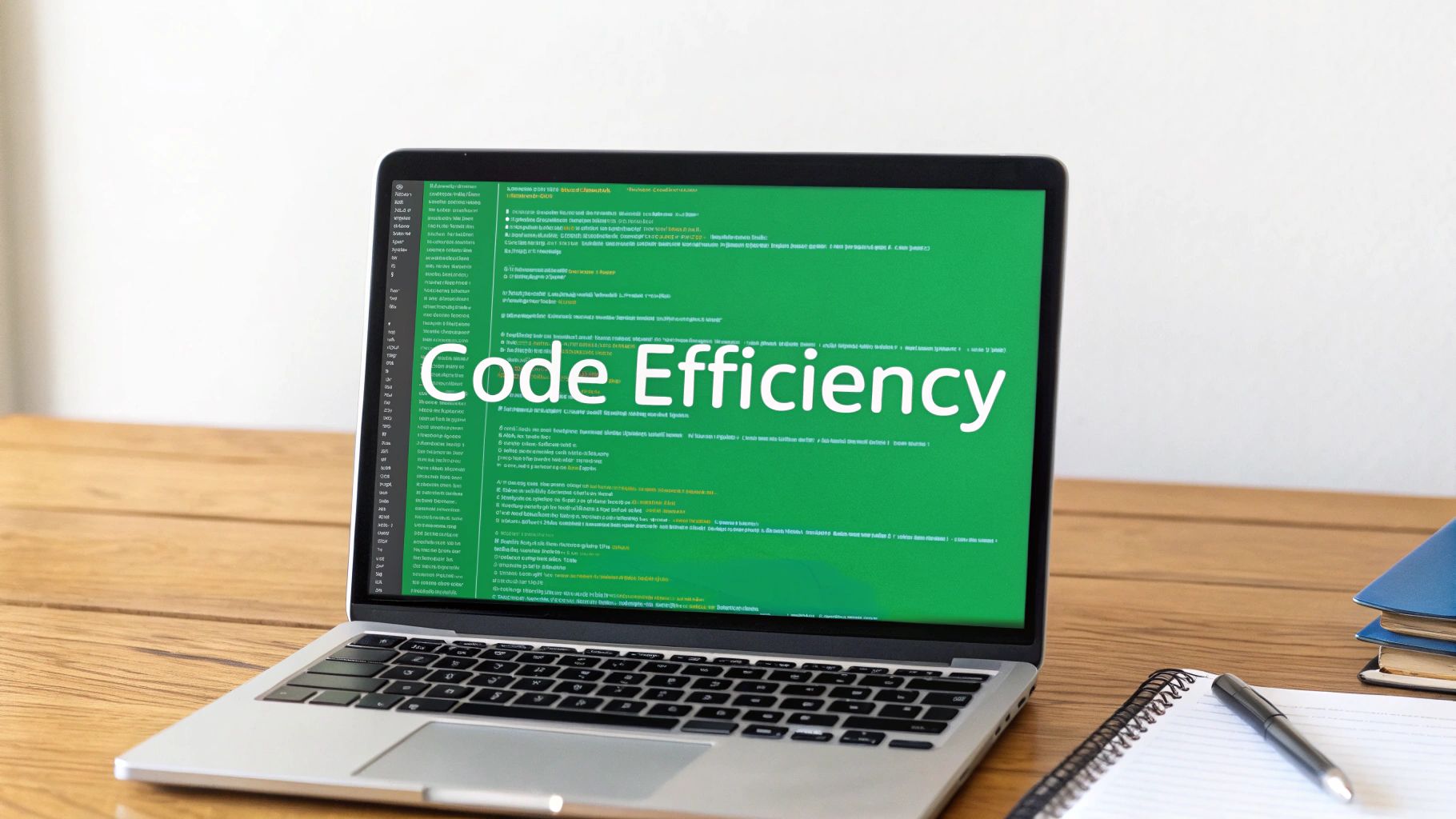The Evolution of Modern Developer Productivity

Measuring how well developers perform their work presents an ongoing challenge for software organizations. While it may seem straightforward to track metrics like lines of code or bugs fixed, these numbers only tell part of the story. The reality is that developer productivity involves many interconnected elements - from individual contributions to team collaboration to the business value delivered.
Moving Beyond Traditional Metrics
Simple metrics like counting code output miss crucial aspects of a developer’s impact. Things like code quality, effective problem-solving, and successful teamwork matter just as much but are harder to measure. We need better ways to evaluate developer performance that consider the full scope of their work.
Key areas to measure include:
- Code maintainability and technical debt
- Collaboration and knowledge sharing
- Problem-solving efficiency
- Business value delivered The software industry has developed new frameworks to better capture developer productivity. DORA (DevOps Research and Assessment) focuses on deployment speed and stability metrics. The SPACE framework examines satisfaction, performance, activities, communication, and efficiency. Learn more about these approaches on GetDX’s developer productivity guide.
DORA and SPACE Frameworks in Practice
These modern frameworks provide deeper insights by looking at multiple productivity factors. DORA’s metrics help teams improve their development and deployment practices. The SPACE framework adds a human element by considering developer satisfaction and team dynamics. Organizations can mix and match elements from both approaches based on their specific needs.
Finding the Right Balance
Numbers tell an important part of the story, but they’re not everything. Regular feedback from code reviews, peer evaluations, and self-assessments provides essential context about a developer’s work. The most effective approach combines hard metrics with qualitative insights to build a complete picture of developer productivity.
By gathering both types of data, teams can:
- Identify areas for improvement
- Support developer growth
- Make better decisions about processes and tools
- Foster a culture of continuous learning This balanced strategy helps organizations improve both individual performance and team success while maintaining high quality standards.
Mastering the DORA Framework for Real Results

The DORA framework has fundamentally changed how teams measure software development success. Instead of tracking individual developer output, it focuses on team-level metrics that directly connect to business outcomes. Let’s explore what makes DORA effective and how your team can use it to deliver better results.
Understanding the Core DORA Metrics
To help teams make data-driven improvements, let’s break down the key metrics and their importance:
These four metrics give teams clear insight into their delivery speed and stability. Teams can use this data to identify bottlenecks and track improvements over time. For more details on measuring developer productivity, check out Pluralsight’s blog on developer productivity.
Implementing DORA in Your Organization
Getting started with DORA requires a thoughtful approach. Here are the key steps:
- Establish Baselines: Measure current performance across all four metrics to create your starting point
- Set Realistic Goals: Choose achievable targets that make sense for your team and business
- Choose the Right Tools: Set up automated data collection through your CI/CD and monitoring tools
- Build Learning Culture: Make regular metric reviews and experimentation part of your process
Real-World Examples and Benefits
Many teams have seen major gains after adopting DORA metrics. Some have cut their lead times from weeks down to hours, letting them respond faster to customer needs. Others have reduced failure rates significantly, leading to more stable systems.
The business impact is clear - faster delivery of new features, fewer production issues, and happier customers. By focusing on these metrics and making steady improvements, teams can dramatically improve their software delivery capabilities.
Focus on gradual progress rather than dramatic changes. Small, consistent improvements in each metric will add up to significant results over time. The key is to keep measuring, learning, and refining your approach based on what the data tells you.
Implementing the McKinsey Developer Velocity Index

While DORA metrics give us solid data on developer output, many teams need deeper insights. The McKinsey Developer Velocity Index (DVI) fills this gap by looking beyond just speed and stability. This broader view helps teams spot exactly where they need to improve their software development practices.
Key Components of the DVI
The DVI looks at three main areas to measure developer effectiveness:
- Technology: The actual tools and platforms that developers use daily. Having the right tech stack makes a huge difference in how well teams can work.
- Working Practices: The specific ways teams handle their work - from code reviews to release processes. Good practices help developers focus on building great software.
- Organizational Support: How well the company supports its developers through resources, culture, and management backing. When developers have what they need, they do their best work.
Measuring and Interpreting the DVI
Unlike DORA’s pure numbers approach, the DVI mixes survey feedback with hard data. Teams can see both what the metrics say and how developers actually feel about their work environment. For instance, you might find that while deployment numbers look good, developers are struggling with outdated tools.
This combined view helps paint a clearer picture of what’s working and what isn’t. Teams can then make better choices about where to focus their improvement efforts.
Benefits of Implementing the DVI
Companies using the DVI have seen real improvements in their development process. McKinsey’s studies show impressive results - teams achieved a 20-30% drop in customer-reported bugs and 20% better employee satisfaction scores. Learn more about measuring developer productivity in McKinsey’s research. These improvements lead directly to better products and happier development teams.
Adapting the DVI for Your Organization
The DVI works best when adjusted to fit your specific needs. Think about your team size, the types of projects you work on, and any special requirements in your industry. Pick the metrics and survey questions that make sense for your situation.
This customization ensures you’re tracking what matters most to your team’s success. It helps you focus on the areas that will make the biggest difference in your development process, leading to better results overall.
Success Stories: How Tech Giants Measure Performance

Looking at how major tech companies measure developer productivity offers valuable lessons for teams of all sizes. Let’s explore how companies like Google, Amplitude, and Intercom build their measurement systems. Their experiences show that mixing data with human insight leads to the most meaningful results.
Google’s Approach: Speed, Ease, and Quality
Google’s Developer Intelligence team focuses on three key areas: speed, ease, and quality. Rather than just tracking how fast developers work, they look at the full picture of efficient and effective code delivery. During code reviews, they measure:
- Time to complete reviews (speed)
- How smoothly the process flows (ease)
- Quality of feedback provided This multi-angle view helps them understand performance during critical development stages.
Amplitude and Intercom: Focusing on Delivery
Companies like Amplitude and Intercom put special emphasis on making code deployment smooth and simple. They’ve found that when developers can easily ship their work, overall productivity improves. This focus encourages better code quality too - developers naturally write cleaner code when they know it needs to deploy smoothly.
Diverse Metrics for a Complete Picture
These real-world examples show how different companies measure success in different ways. While Google looks closely at code review metrics, Amplitude and Intercom focus more on deployment ease. You can learn more details in this research on developer productivity. The key takeaway? No single metric tells the whole story - you need a mix of measurements.
Making It Work for Your Team
While we can learn from big tech companies, it’s important to adapt their methods to fit your needs. A small startup might care most about quick releases, while larger companies often focus more on maintaining code quality over time. The best metrics depend on your team’s specific goals and challenges.
Building Better Through Measurement
Smart teams use metrics not just to track progress, but to keep getting better. Regular metric reviews and developer feedback help spot problems, improve processes, and create a more productive environment. This ongoing cycle of measurement and improvement helps teams learn and grow stronger over time.
Building Your Measurement System That Works
Creating an effective developer productivity measurement system requires thoughtful planning and ongoing refinement. The key is finding metrics that match your specific team’s needs and creating feedback loops that encourage growth.
Defining Your Objectives and Scope
Start by clearly outlining what “productivity” means for your team. Your goals might include faster shipping, better code quality, or improved teamwork. For example, if you want to speed up delivery, focus on metrics like Deployment Frequency and Lead Time for Changes from the DORA framework.
Think about your measurement scope - are you looking at individual developers, teams, or the whole organization? Your choice will affect which metrics make sense and how to gather them effectively. The goal is getting useful insights at the right level.
Selecting the Right Metrics for Your Team
One metric alone can’t show the full picture. You need both numbers and feedback to understand not just what’s happening, but why. Here are the key types of metrics to consider:
- Output Metrics: These track concrete results like code volume, features shipped, or bugs fixed. While easy to measure, they only tell part of the story. Focusing too much on output can hurt quality.
- Outcome Metrics: These measure real impact through customer satisfaction, revenue, or user engagement. They connect developer work to business results.
- Qualitative Metrics: These include code reviews, team feedback, and self-evaluation. They add important context about collaboration and problem-solving.
Productivity Metrics Selection Guide
The table below helps teams choose metrics based on their size and goals:
Building a Feedback Loop for Continuous Improvement
Measuring should drive positive change, not just track numbers. Set up regular team reviews to discuss metrics and plan improvements. This builds a culture of growth and turns insights into action. For instance, if you notice high failure rates, work with your team to improve testing practices.
Remember to review your measurement approach too. As your team grows and goals shift, your metrics may need updates. Regular evaluation keeps your system useful and relevant. Think of productivity measurement as an ongoing process - it grows and changes with your team.
The Future of Developer Performance Measurement
The process of measuring developer productivity continues to shift as teams discover new ways to evaluate and improve performance. The focus is moving away from basic metrics toward methods that give a more complete picture of how developers contribute.
AI-Powered Analytics and Predictive Modeling
AI analytics tools are changing how we understand developer performance. These systems can process huge amounts of code, project data, and team communications to spot important patterns. For example, AI helps identify when developers might be getting overwhelmed or when projects could face delays. This helps managers step in early to keep teams working smoothly.
AI also makes it possible to give developers more personalized feedback. By looking at each person’s work patterns and contributions, AI can suggest specific areas for growth and connect developers with the right training or mentors to help them improve.
The Rise of Collaboration Metrics
Modern software development relies heavily on teamwork, making it essential to measure how well developers work together. New tools focus on tracking collaboration patterns - how teams share knowledge, communicate, and solve problems as a group. This helps spot issues like information bottlenecks or uneven workloads that might slow the team down.
Focus on Outcomes Over Outputs
What matters most isn’t the amount of code written, but the real impact it has. Teams are shifting from measuring outputs (like code volume) to tracking outcomes that affect the business - things like how many users engage with new features or how they improve customer satisfaction. This keeps development work aligned with what really matters for the company’s success. Learn more in our article about How to improve developer productivity.
Adapting to Distributed Teams
Remote work has changed how we need to think about measuring productivity. Old methods that worked for office teams often don’t fit remote settings. Teams need new ways to track things like how well people communicate in virtual meetings and how information flows between remote team members.
Preparing for the Future of Measurement
To stay effective, organizations should: